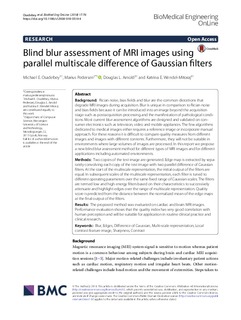| dc.contributor.author | Osadebey, Michael | |
| dc.contributor.author | Pedersen, Marius | |
| dc.contributor.author | Arnold, Douglas | |
| dc.contributor.author | Wendel-Mitoraj, Katrina | |
| dc.date.accessioned | 2018-08-13T13:41:07Z | |
| dc.date.available | 2018-08-13T13:41:07Z | |
| dc.date.created | 2018-08-10T08:01:59Z | |
| dc.date.issued | 2018 | |
| dc.identifier.issn | 1475-925X | |
| dc.identifier.uri | http://hdl.handle.net/11250/2557779 | |
| dc.description.abstract | Background: Rician noise, bias felds and blur are the common distortions that degrade MRI images during acquisition. Blur is unique in comparison to Rician noise and bias felds because it can be introduced into an image beyond the acquisition stage such as postacquisition processing and the manifestation of pathological condi tions. Most current blur assessment algorithms are designed and validated on con sumer electronics such as television, video and mobile appliances. The few algorithms dedicated to medical images either requires a reference image or incorporate manual approach. For these reasons it is difcult to compare quality measures from diferent images and images with diferent contents. Furthermore, they will not be suitable in environments where large volumes of images are processed. In this report we propose a new blind blur assessment method for diferent types of MRI images and for diferent applications including automated environments. Methods: Two copies of the test image are generated. Edge map is extracted by sepa rately convolving each copy of the test image with two parallel diference of Gaussian flters. At the start of the multiscale representation, the initial output of the flters are equal. In subsequent scales of the multiscale representation, each flter is tuned to diferent operating parameters over the same fxed range of Gaussian scales. The flters are termed low and high energy flters based on their characteristics to successively attenuate and highlight edges over the range of multiscale representation. Quality score is predicted from the distance between the normalized mean of the edge maps at the fnal output of the flters. Results: The proposed method was evaluated on cardiac and brain MRI images. Performance evaluation shows that the quality index has very good correlation with human perception and will be suitable for application in routine clinical practice and clinical research. | nb_NO |
| dc.language.iso | eng | nb_NO |
| dc.publisher | BioMed Central | nb_NO |
| dc.rights | Navngivelse 4.0 Internasjonal | * |
| dc.rights.uri | http://creativecommons.org/licenses/by/4.0/deed.no | * |
| dc.title | Blind blur assessment of MRI images using parallel multiscale difference of Gaussian filters | nb_NO |
| dc.type | Journal article | nb_NO |
| dc.type | Peer reviewed | nb_NO |
| dc.description.version | publishedVersion | nb_NO |
| dc.source.volume | 17 | nb_NO |
| dc.source.journal | Biomedical engineering online | nb_NO |
| dc.source.issue | 76 | nb_NO |
| dc.identifier.doi | 10.1186/s12938-018-0514-4 | |
| dc.identifier.cristin | 1600877 | |
| dc.relation.project | Norges forskningsråd: 247689 | nb_NO |
| dc.description.localcode | © The Author(s) 2018. This article is distributed under the terms of the Creative Commons Attribution 4.0 International License (http://creativecommons.org/licenses/by/4.0/), | nb_NO |
| cristin.unitcode | 194,63,10,0 | |
| cristin.unitname | Institutt for datateknologi og informatikk | |
| cristin.ispublished | true | |
| cristin.fulltext | postprint | |
| cristin.qualitycode | 1 | |

